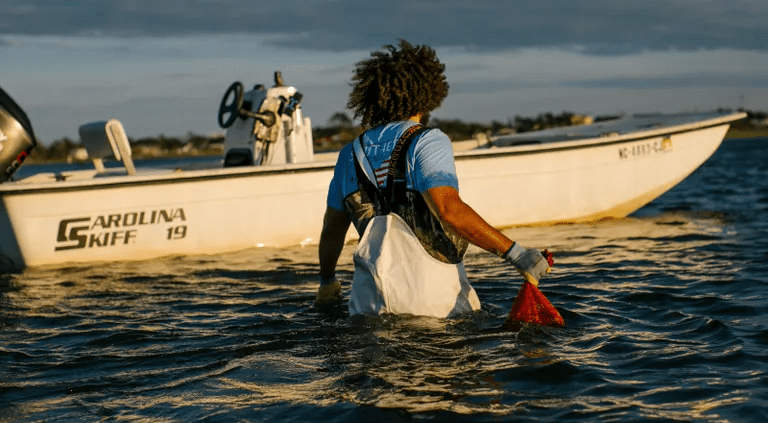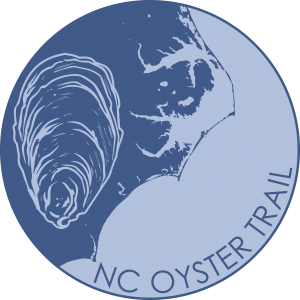The fisherfolk revival of North Carolina
The oysters that cluster more than 300 miles of coastline are bringing in tourists from across the globe. Here, we explore just why the briny shellfish is reason alone to visit.
by Ellen Himelfarb on March, 14 2023 | Reprinted from National Geographic
The coast of North Carolina fans out like a scallop’s edge, forming hidden inlets caressed by warm breezes. It’s positively spoiled for shoreline — blessed twice over due to the wispy chain of barrier islands with their heroic dunes and salt marshes.
And yet in the whip-thin towns of the Outer Banks and beaches to the south, people must surely be outnumbered by the scoops of pelicans that glide overhead. The coastal lowlands are as far from an international airport as London is from Lockerbie and unrecognisable from the wild Appalachian mountainscapes inland. This makes the coast a blessed find for outsiders seeking a windswept retreat with notes of romance and history.
The residents like it that way. Their life here is bound up in the brittle coastline and fragile ecosystem of flora and fauna that’s been in slow decline since British settlers arrived in the 16th century. And now, they’ve seized the opportunity to reverse the effects of historic overharvesting and environmental stressors.
The North Carolina merroir (a play on ‘terroir’ used by the marine farming sector) has such high concentrations of salt that you can practically smell it through the cordgrass. Some varieties, like the Crab Slough oyster found off Cape Hatteras, house a tiny pea crab in the place of a pearl. As they mature, they absorb nutrients and filter impurities like excess carbon through their gills, making the water more hospitable for other sea life. Truly, they’re superheroes of underwater multitasking.

Locals have responded on every front to the challenges of rebuilding the oyster industry. “Willis Brother’s Seafood was an economic hub of our county. Over time, the building became a dilapidated eyesore. I had so many fond memories growing up here, so we purchased it in 2015,” says Sue Hill of Down East Mariculture, a hatchery providing farmers along the coast with oyster seedlings, or ‘spat’. “I had no idea what I was going to do with the building, but I knew I wanted to do something to help commercial fishermen and women who couldn’t make a living doing what their families have done for generations. Mariculture is a relatively new, growing industry in North Carolina. So, I thought, I can do that!”
Those teardrop-shaped clams are like fossils scarred with the history of the Old South. Beloved by the Algonquin natives and netted out of vast reefs by British settlers, the eastern oysters delighted early Americans and kept Southerners working in the battered post-Civil War economy. Fishermen of the last century dredged stocks to almost nothing, though, while hurricanes and pollution did their own damage.

In the years before the pandemic, coastal North Carolina embraced a new ambition, and that’s to become for oyster-lovers what Napa Valley is to oenophiles. In 2020, the North Carolina Oyster Trail launched with an online map of major sites for spotting, purchasing, eating and celebrating oysters. What’s made this possible is the proliferation of oyster farming in this stretch of the Eastern Seaboard.
Unlike the wild kind, farmed oysters don’t spawn and grow according to season — they mature year-round to a uniform size that looks tantalising by the half-shell on a bed of ice. Small-scale growers nurture them from minuscule spat, and ‘plant’ them in mesh beds that bob on the water. And together they’ve put the state back at the shucking-edge of the oyster business. “Our first season, we worked with two oyster farmers,” says Hill. “Five seasons later, we now work with 64.”
Operations like Hill’s are the heart and soul of the Oyster Trail, offering the sort of experiences that make a holiday. At Slash Creek Oysters up the coast on Pamlico Sound, Katherine McGlade and Spurgeon Stowe take visitors round their farm on a boat called Half Shell to watch tidal seawater wash through blooming molluscs. And at Oysters Carolina on the shellfish sanctuary of Harkers Island, local legend Ryan Bethea conducts tasting odysseys around the salty Back Sound by kayak.
Blue Water Grill, a casual, woody affair on Roanoke Island with fishing nets hanging from the rafters, has always managed to elevate the oyster, much to the delight of longtime customers. The restaurant is celebrated for its October oyster roasts and bloody Mary pairings. Now, with the mariculture boom, owner Scott Shields no longer has to dispel the notion that oysters shouldn’t be eaten in a month without an ‘r’. Oyster farms override that old prohibition, which is linked to regulations for the wild oyster harvest.
For locavores seduced by a fleshy oyster doused with jalapeno remoulade, there’s no better setting for slurping than a family business whose owners fish to live and live to fish. As for the tropical climate, 400-year history and inconceivable quiet… they’re like the spicy dash of Tabasco on top.
Plan your trip
To discover more about North Carolina and how to book your trip, visit travelsouthusa.com and visitnc.com




